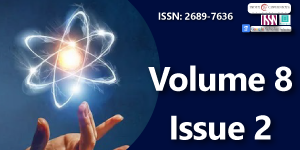Heuristic Approach to Quantum Gravity in Terms of Incremental Curvature of Spacetime
Main Article Content
Abstract
Abstract
Physicists since Einstein have pondered how gravitation and quantum mechanics could be connected fundamentally given widely differing scales and mathematical formalism. Gravitational bending of light in null geodesics around an isolated point mass, curved incrementally to Compton’s wavelength is proposed to associate semi-classical particle interactions with quantum wave phenomena. Although a basic methodology rather than a full quantum theory of gravity, this path leads to a simple expression of gravity at the quantum level in terms of constants ℏ, c, and G, with mass as the source of gravitational curvature. When taken further to the Planck scale, quantized spacetime curvature is the square of the inverse Planck length which is a constant and the canonical inner boundary of spacetime. This elementary thought experiment of spacetime curvature taken to the Planck limit arrives at the ultimate state where quantum gravity existed in the very early universe. This state may also exist at the smallest scales in the current universe as curvature entanglement at nearly undetectable low energy due to the relative strength of gravity.
Downloads
Article Details
Copyright (c) 2025 Powell JR.

This work is licensed under a Creative Commons Attribution 4.0 International License.
Bohr N. About the Serial Spectra of the Elements. Zeitschrift für Physik. 1920;2(5):423-469. Available from: https://www.scirp.org/reference/referencespapers?referenceid=3254592
Lambourne R. Relativity, Gravitation and Cosmology. Cambridge University Press. 2010. Available from: https://www.cambridge.org/in/universitypress/subjects/physics/cosmology-relativity-and-gravitation/relativity-gravitation-and-cosmology?format=PB&isbn=9780521131384
Smolin L. Einstein’s Unfinished Revolution. New York: Penguin Press. 2019. Available from: https://www.amazon.in/Einsteins-Unfinished-Revolution-Lee-Smolin/dp/014197916X
Oesch P, Brammer G, van Dokkum PG, Illingworth GD, Bouwens RJ, Labbé I, et al. A Remarkably Luminous Galaxy at Z=11.1 Measured with Hubble Space Telescope GRISM Spectroscopy. arXiv:1603.00461v1 [astro-ph.GA]. 2016 Mar 1. Available from: https://ui.adsabs.harvard.edu/abs/2016ApJ...819..129O/abstract
Hossenfelder S. Minimal Length Scale Scenarios for Quantum Gravity. Living Rev Relativ. 2013;16(2). Available from: https://link.springer.com/article/10.12942/lrr-2013-2
Smolin L. Three Roads to Quantum Gravity. New York: Basic Books/Perseus Books Group. 2001. Available from: https://www.amazon.in/Three-Roads-Quantum-Gravity-Smolin/dp/0465094546
Compton A. A Quantum Theory of the Scattering of X-Rays by Light Elements. Phys Rev. 1923;21(5):483-502. Available from: https://journals.aps.org/pr/abstract/10.1103/PhysRev.21.483
Amelino-Camelia G, Rosati G, Bedic S. Phenomenology of Curvature-Induced Quantum Gravity Effects. arXiv:2012.07790v1 [gr-qc]. 2020. Available from: https://doi.org/10.48550/arXiv.2012.07790
Berry M. Principles of Cosmology and Gravitation. Cambridge, UK: Cambridge University Press. 1976. Available from: https://archive.org/details/principlesofcosm0000berr/page/n7/mode/2up
Personal Communication with Prof. Michael Berry. H H Wills Physics Laboratory, Bristol, UK. 2020. Available from: https://www.bristol.ac.uk/people/person/Michael-Berry-f4aba075-921c-4697-a1d3-32256fa63b02/
Tavoro M. Einstein’s Gravity, The Bending of Light and How He Became the World’s Most Famous Scientist, An Explanation of the Gravitational Bending of Light by the Sun. Available from: https://medium.com/towards-data-science/einsteins-gravity-theory-and-the-bending-of-light-by-the-sun-1e796626dc19
Alexandrov A, Sliuser V, Zhdanov V. Verification of Einstein’s Formula for Gravitational Deflection of Light Using Observations of Galactic Microlensing. arXiv:2004.07522 [gr-qc]. 2020 Apr 16. Available from: https://doi.org/10.48550/arXiv.2004.07522
Bartelmann M, Maturi M. Weak Gravitational Lensing. arXiv:1612.06535v1 [astro-ph.CO]. 2016 Dec 20. Available from: https://doi.org/10.48550/arXiv.1612.06535
Wessel W. On Relativistic Quantum Mechanics and the Mass Operator. Phys Rev. 1951;83(5):1031-1037. Available from: https://journals.aps.org/pr/abstract/10.1103/PhysRev.83.1031
Greenberger D. Conceptual Problems Related to Time and Mass in Quantum Theory. (Paper prepared for a talk at a conference at Oxford University honoring Prof. John Polkinghorne on his 80th birthday, Sept. 2010). arXiv:1011.3709. Available from: https://doi.org/10.48550/arXiv.1011.3709
Landau L, Lifshitz E. The Classical Theory of Fields: Course of Theoretical Physics, Fourth Revised English Edition. Pergamon Press; 1975. Available from: https://www.aldebaran.cz/studium/books/1994_Landau_Lifshitz-Fields.pdf
Planck M. The Theory of Heat Radiation. New York: Dover Publications, Inc.; 1914. Available from: https://gutenberg.org/files/40030/40030-pdf.pdf
Birrell N, Davies P. Quantum Fields in Curved Space. Cambridge University Press; 1984. Available from: https://www.cambridge.org/core/books/quantum-fields-in-curved-space/95376B0CAD78EE767FCD6205F8327F4C
Eddington A. Report on the Relativity Theory of Gravitation. The Physical Society of London. 1920. Available from: https://archive.org/details/reportontherelat028829mbp
Hawking S. Particle Creation by Black Holes. Commun Math Phys. 1975;43:199-220. Available from: https://link.springer.com/article/10.1007/BF02345020
Wald R. General Relativity. Chicago and London: The University of Chicago Press. 1989. Available from: https://cdn.preterhuman.net/texts/science_and_technology/physics/General_Relativity_Theory/General%20Relativity%20-%20R.%20Wald.pdf
Pathria R, Beale P. Statistical Mechanics. 3rd ed. Elsevier. 2011. Available from: http://linux0.unsl.edu.ar/~froma/MecanicaEstadistica/Bibliografia/PathriaBeale.pdf
Hawking S. Gravitationally Collapsed Objects of Very Low Mass. Mon Not R Astr Soc. 1971;152:75-78. Available from: https://doi.org/10.1093/mnras/152.1.75
Bekenstein J. Universal Upper Bound on the Entropy-to-Energy Ratio for Bounded Systems. Phys Rev D. 1981;23:287-342. Available from: https://journals.aps.org/prd/abstract/10.1103/PhysRevD.23.287
Carney D, Müller H, Taylor J. Using an Atom Interferometer to Infer Gravitational Entanglement Generation. PRX Quantum. 2021;2:030330. Available from: https://journals.aps.org/prxquantum/abstract/10.1103/PRXQuantum.2.030330
Wallace D. Quantum Gravity at Low Energies. arXiv:2112.1223 [gr-qc]. 2021. Available from: https://arxiv.org/abs/2112.12235
Rovelli C. Quantum Gravity. Scholarpedia. 2008;3(5):7117. Available from: http://www.scholarpedia.org/article/Quantum_gravity
Discussion with Freeman Dyson, “Freeman Dyson: Why General Relativity and Quantum Mechanics Can’t Be Unified”. 2017. Available from: https://www.youtube.com/watch?v=pcicI_GJGcM

